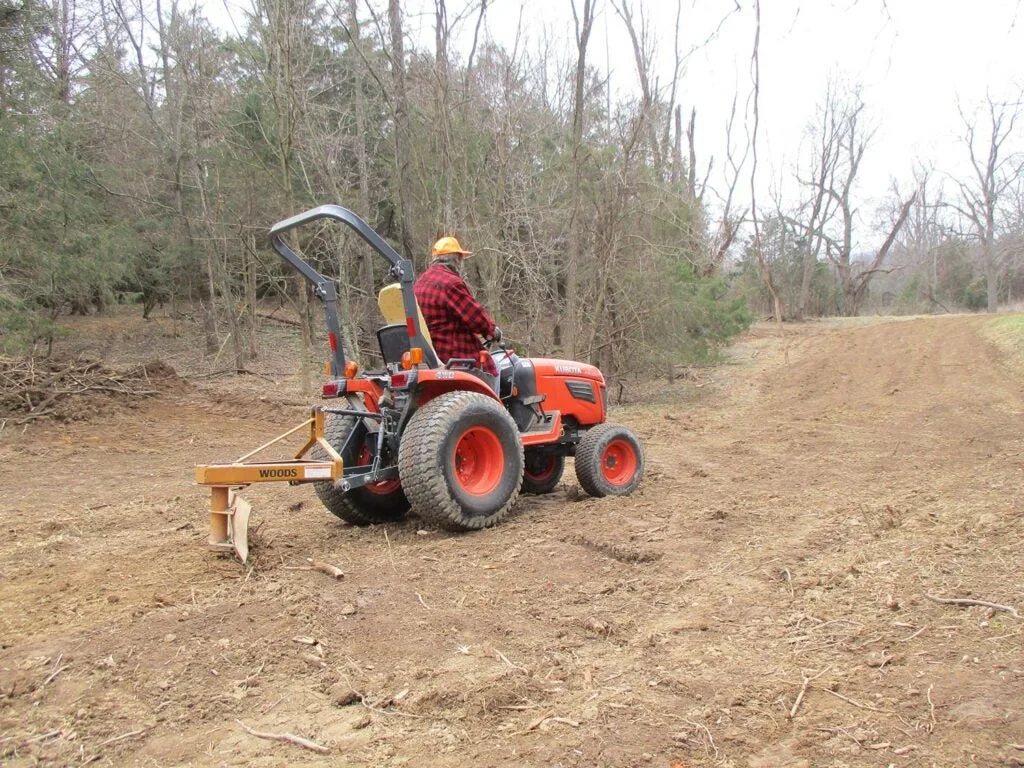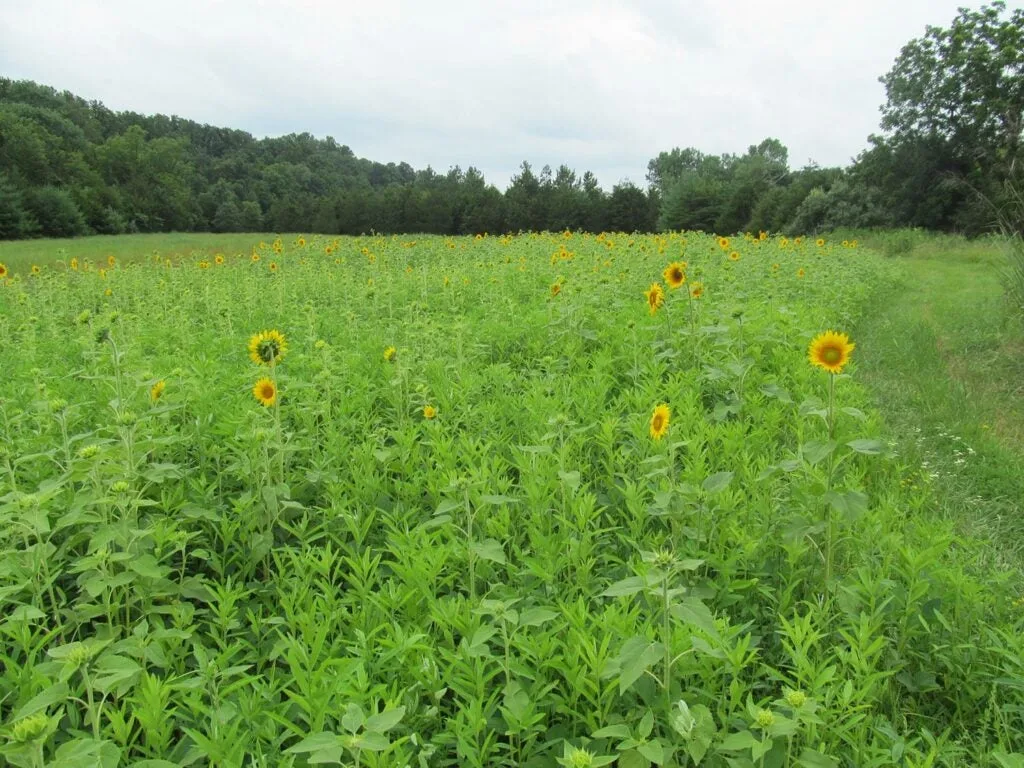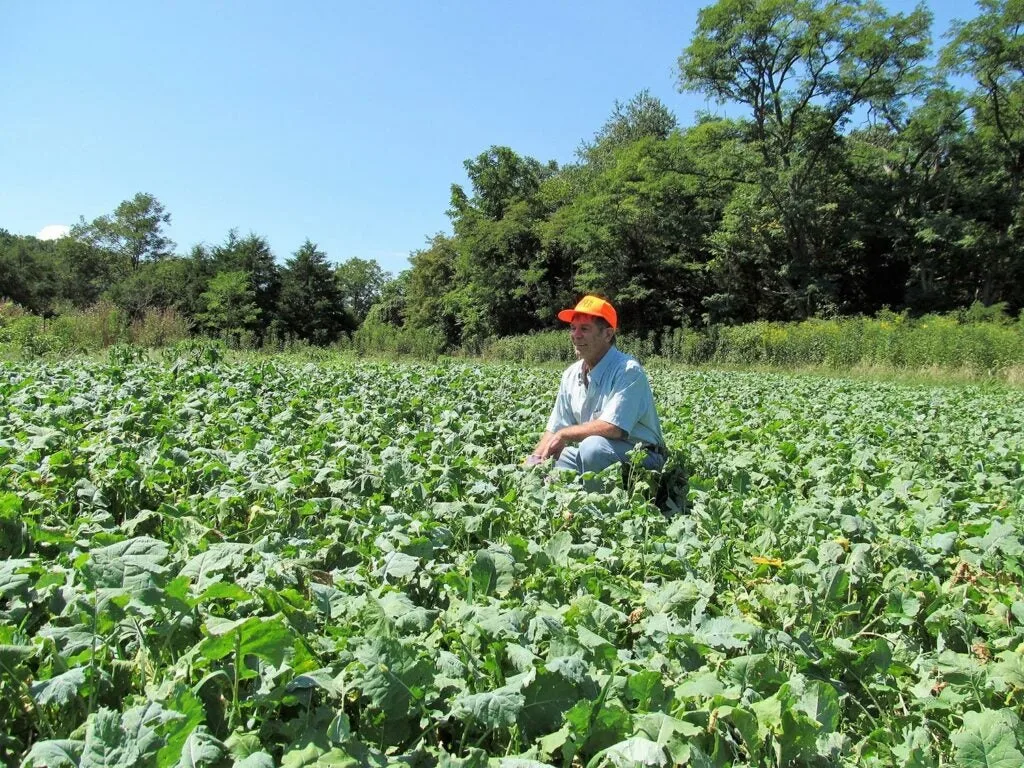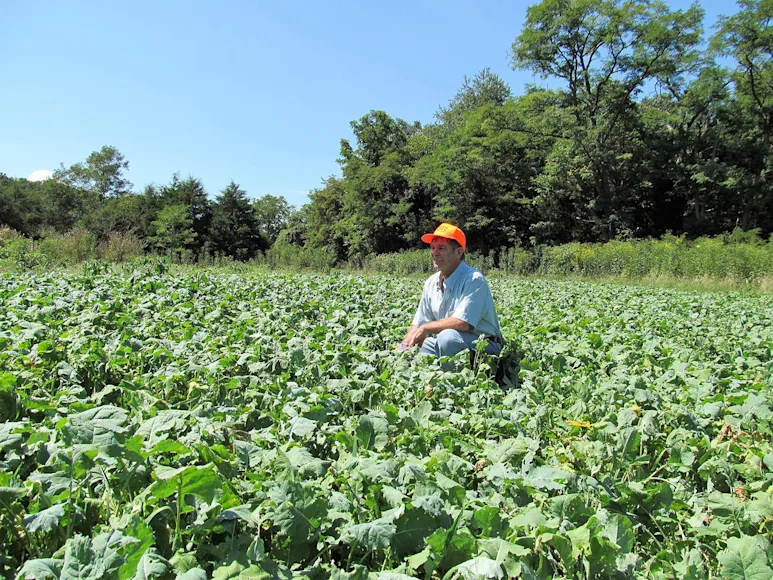Frigid air, frozen fields, and ground as hard as granite might not have you thinking about food plots. But if you want fields of deer forage next fall that will attract and nurture heavy-racked bucks, now is the time to start planning, preparing, and in one unique case, actually sowing seed.
The best deer managers never fully take the winter off. They’re busy strategizing and completing any tasks they can get done ahead of time. Then when planting time arrives fields will be smooth and rock-free; the soil will be tested, tilled, and pH balanced; the fertilizer applied, and hopefully, several new plots will be ready in addition to established ones.
Once spring comes, that will just leave the easy afternoon job of spreading seed and tamping it down—leaving you free to chase bass and trout, set up trail cams, hang stands, and watch your well-planned buffet grow into a lush green field of deer forage.
Winter food plot work consists of two main parts: planning and preparation.

The author tills a plot in late winter. Any day the ground isn’t frozen, start breaking down the soil to pulverize weeds and work it to a fine texture for planting seeds such as clover, alfalfa, and chicory. Gerald Almy
Table of Contents
Identify Where to Plant Your Food Plot
Flag Areas for Kill Plots
Find Places for Nutrition Plots
Pick What You’re Going to Plant
Maintain Food Plot Equipment
Clear the Land for Planting a Food Plot
Order Food Plot Seed
Test Your Soil
Add Lime to the Soil
Frost Seeding
How to Plan a Food Plot
Identify Where to Plant Your Food Plot
Draw a map of your property showing barren fields and areas already used for plots. Then try to analyze your setup based on where buck bedding areas are, where stands can be hung, and where new plots would be strategically useful. Use satellite photos, topo maps, and boot work to determine if they are feasible for plots and plan what needs to be done in terms of clearing and brushwork to get them ready. If heavy equipment is required, hire an operator now before he’s busy in spring digging house foundations.
Flag Areas for Kill Plots
Check out log landings, skid trails, and natural openings in the woods that might make good “kill plots” for waylaying a mature buck close to his bedding area. Mark them to clear later as needed with a chain saw, hand tools, tractor, or ATV. Make sure you can access these spots without blowing deer out when you hunt them and that prevailing winds are favorable. Planting a woods plot you can’t hunt makes no sense.
Find Places for Nutrition Plots
Also, look for larger areas like neglected fields or openings in more accessible spots that could make good nutrition plots. They may just require mowing and spraying with a non-selective herbicide such as glyphosate once the weather warms to turn into a plot that will draw deer onto your property. For nutrition plots, you don’t have to worry about wind direction or access, since you’ll be planting them to attract deer and improve the herd, not to hunt.

Take care of all the projects you can ahead of time to be ready for spring and summer. These are warm season annuals—soybeans, sunn hemp, sunflowers, lablab. Gerald Almy
Pick What You’re Going to Plant
If you just want to draw in deer to shoot, fall annuals are all you need. A good food-plot program
, though, should provide year-round forage to hold deer on the property and improve the quality of the animals. That means three offerings: perennials, warm-season annuals, and cool-season plants such as cereal grains and brassicas. Perennials provide great early-season nutrition
. Warm-season annuals offer summer forage. Fall crops such as oats, wheat, and radishes provide vital energy and carbohydrates as deer bulk up for winter—as well as prime hunting sites.
If you have any fields two acres or larger, plan on putting warm-season annuals in some of them, such as forage soybeans, cowpeas, lablab, sunn hemp, and sunflowers, or pre-mixed blends like Power Plant. A lot of hunters don’t bother with these summer crops, but that’s why you want to have them. They offer high protein (up to 35 percent) and thick cover as the beans climb and wrap around structure-providing plants like sunn hemp and sunflowers. The cover these annuals provide is so thick that deer will often bed right in the plot.
Also plan on perennials such as white clover, chicory, and alfalfa in areas with high-quality soil. For these plots, it’s important to have a smooth, finely-tilled bed so the tiny seeds aren’t buried. Try to get out any days the ground is unfrozen and make multiple tilling or disking passes to break up the dirt. This will also help with weed control by pulverizing the roots.
Read Next: Deer Season’s Over. Time to Start Scouting
Finally, save several plot locations for fall annuals including cereal grains such as wheat, triticale, and oats as well as a variety of brassicas including kale, rape, and turnips. Annual clovers like crimson and arrowleaf can be mixed in for added palatability. These are called “fall” crops but need to be planted from July to September to grow the most forage. The cereal grains mixed with clover attract deer first while the brassicas stand tall and are accessible above snow in northern areas for late-season forage.
Getting these plots prepared now puts you ahead of the game. On your map, mark what forages will go in each location and an approximate date for planting so you have a game plan when spring arrives and things get hectic.
How to Prepare a Plot This Winter
Maintain Food Plot Equipment
Start with your equipment. Nothing is more frustrating than heading out for a full day of food plot work and finding your tractor won’t start or the tiller needs repair. This means oil changes, lube, and tune-ups, for ATVs and small tractors. Lubricate and check the condition of sprayers and seeders, and replace or sharpen blades on tillers.
Clear the Land for Planting a Food Plot
For the plots, the first step is clearing off tree branches, rocks, and wind-blown debris. If a plot is getting too much shade, now is the time to trim back surrounding trees to allow more daylight in. Most food plot forages require at least 4-5 hours of sunlight daily. Make a note of which fields have bad weed problems, and spray those areas with glyphosate once temperatures warm and the weeds green-up.

Order seeds early in case some varieties you want sell out closer to planting time. Gerald Almy
Order Food Plot Seed
Order seed now, erring on the side of too much. Saving some that’s leftover is not a problem. Almost all good food plot seeds will germinate a year later.
Test Your Soil
Testing soil is inexpensive, and it provides vital information to grow different crops successfully
. Sure, you can use a generic fertilizer mix, but it won’t always provide the exact nutrients that your dirt needs. And if the pH is bad, you’ll simply be throwing money down the drain.
Your soil’s pH should be at least 6.0, and the ideal is 6.5-7. If it’s below that, it is acidic and electromagnetically “binds up” vital nutrients, making them unavailable to plants. No matter how much fertilizer you add, it won’t help the plants if the pH is much below 6.5. Having the right pH ensures that the forage will be able to absorb the soil’s nutrients and transfer those to the deer that eat them.
To take a sample, use a small shovel or soil probe and a clean bucket. Dig from several areas in each plot and mix the soil in the bucket, then put it in the soil test kit envelope and take that to your local farm co-op or send it to companies such as Whitetailinstitute.com
.

Getting plots—like this brassica plot—ready now ensures the pH will be right, fertilizer and lime added, the plot tilled to a fine texture, and weeds taken care of. Gerald Almy
Add Lime to the Soil
The soil test will tell you two vital things: pH and exactly what fertilizers you need. If your pH is low and your soil is too acidic, adding lime will neutralize it.
Late winter is the perfect time to add lime. It takes a few months to work into the soil, and the frozen ground makes it easy to get a truck into your food plot. You can hire farm co-ops or fertilizer companies, or you can spread it yourself. My local co-op charges $25-35 per ton for lime including spreading. Closer to planting time, when the soil isn’t frozen, you can till in the fertilizer. Follow the guidelines on your soil test for proportions of nitrogen, phosphorus, and potassium needed.
Read Next: How to Plant the Perfect Half-Acre Food Plot for Whitetail Deer
Frost Seeding
Besides these planning and preparation steps, there is one type of planting that you can actually do during the winter. If you have perennial clover or alfalfa plots that are thin or spotty and need filling out, spread seed over them, even if there’s snow on the ground. When the snow melts the seeds will settle. The freezing and thawing action of the soil works these tiny seeds into the surface layer. When temperatures warm they’ll germinate and make for a lush thick plot more attractive to deer.
Take care of these planning and preparation steps now and soon it will be time for the most enjoyable food plot project of all—sowing seed and watching it grow into tall green forage that draws in big-racked bucks and healthy does.
FAQs
Can you plant a food plot in winter?
During the last few weeks of winter, you can do what’s called frost seeding for some types of seeds. To frost seed, you broadcast seeds on frozen, snow-covered ground. As the snow melts and the ground thaws, the seeds will work their way into the soil and germinate. Most food plotters do this to bulk up alfalfa and clover plots.
What’s the easiest crop to grow for deer?
Red clover is one of the easiest food-plot crops to grow for deer. It’s easy to establish a clover plot and easy to maintain one as well.
What food plot attracts the most deer?
Deer need a variety of plants to eat, and no one type of plant will attract deer year-round. Some good annual plants are corn, soybeans, brassicas, and cereal grains like wheat, triticale, and oats. Some good perennials are white clover, chicory, and alfalfa. Check out our region-by-region guide
to help identify the best food-plot seeds for your area.






